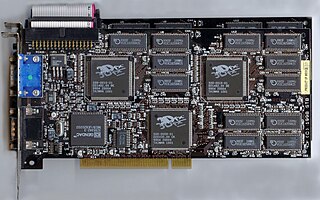
Advanced Micro Devices, Inc. (AMD) is an American multinational semiconductor company based in Santa Clara, California that develops computer processors and related technologies for business and consumer markets. While initially it manufactured its own processors, the company later outsourced its manufacturing, a practice known as fabless, after GlobalFoundries was spun off in 2009. AMD's main products include microprocessors, motherboard chipsets, embedded processors and graphics processors for servers, workstations, personal computers and embedded system applications.

The VESA Local Bus was a short-lived expansion bus introduced during the i486 generation of x86 IBM-compatible personal computers. Created by VESA, the VESA Local Bus worked alongside the then dominant ISA bus to provide a standardized high-speed conduit intended primarily to accelerate video (graphics) operations. VLB provided a standardized "fast path" that add-in (video) card makers could tap for greatly accelerated memory-mapped I/O and DMA, while still using the familiar ISA bus to handle basic device duties such as interrupts and port-mapped I/O.

A workstation is a special computer designed for technical or scientific applications. Intended primarily to be used by one person at a time, they are commonly connected to a local area network and run multi-user operating systems. The term workstation has also been used loosely to refer to everything from a mainframe computer terminal to a PC connected to a network, but the most common form refers to the group of hardware offered by several current and defunct companies such as Sun Microsystems, Silicon Graphics, Apollo Computer, DEC, HP, NeXT and IBM which opened the door for the 3D graphics animation revolution of the late 1990s.
A video card is an expansion card which generates a feed of output images to a display device. Frequently, these are advertised as discrete or dedicated graphics cards, emphasizing the distinction between these and integrated graphics. At the core of both is the graphics processing unit (GPU), which is the main part that does the actual computations, but should not be confused with the video card as a whole, although "GPU" is often used to refer to video cards.
The Intel i860 was a RISC microprocessor design introduced by Intel in 1989. It was one of Intel's first attempts at an entirely new, high-end instruction set architecture since the failed Intel iAPX 432 from the 1980s. It was released with considerable fanfare, slightly obscuring the earlier Intel i960, which was successful in some niches of embedded systems, and which many considered to be a better design. The i860 never achieved commercial success and the project was terminated in the mid-1990s.
GeForce is a brand of graphics processing units (GPUs) designed by Nvidia. As of the GeForce 20 Super series, there have been sixteen iterations of the design. The first GeForce products were discrete GPUs designed for add-on graphics boards, intended for the high-margin PC gaming market, and later diversification of the product line covered all tiers of the PC graphics market, ranging from cost-sensitive GPUs integrated on motherboards, to mainstream add-in retail boards. Most recently, GeForce technology has been introduced into Nvidia's line of embedded application processors, designed for electronic handhelds and mobile handsets.
The GeForce 256 is the original release in Nvidia's "GeForce" product-line. Announced on August 31, 1999 and released on October 11, 1999, the GeForce 256 improves on its predecessor by increasing the number of fixed pixel pipelines, offloading host geometry calculations to a hardware transform and lighting (T&L) engine, and adding hardware motion-compensation for MPEG-2 video. It offered a notably large leap in 3D PC gaming performance and was the first fully Direct3D 7-compliant 3D accelerator.

ATI Technologies Inc. was a semiconductor technology corporation based in Markham, Ontario, Canada, that specialized in the development of graphics processing units and chipsets. Founded in 1985 as Array Technology Inc., the company listed publicly in 1993. Advanced Micro Devices (AMD) acquired ATI in 2006. As a major fabrication-less or fabless semiconductor company, ATI conducted research and development in-house and outsourced the manufacturing and assembly of its products. With the decline and eventual bankruptcy of 3dfx in 2000, ATI and its chief rival Nvidia emerged as the two dominant players in the graphics processors industry, eventually forcing other manufacturers into niche roles.

3dfx Interactive was a company headquartered in San Jose, California, founded in 1994, that specialized in the manufacturing of 3D graphics processing units, and later, graphics cards. It was a pioneer in the field from the late 1990s until 2000.

Double Data Rate 2 Synchronous Dynamic Random-Access Memory, officially abbreviated as DDR2 SDRAM, is a double data rate synchronous dynamic random-access memory interface. It superseded the original DDR SDRAM specification, and is superseded by DDR3 SDRAM. DDR2 DIMMs are neither forward compatible with DDR3 nor backward compatible with DDR.
Power management is a feature of some electrical appliances, especially copiers, computers, CPUs, GPUs and computer peripherals such as monitors and printers, that turns off the power or switches the system to a low-power state when inactive. In computing this is known as PC power management and is built around a standard called ACPI. This supersedes APM. All recent (consumer) computers have ACPI support.

A graphics processing unit (GPU) is a specialized electronic circuit designed to rapidly manipulate and alter memory to accelerate the creation of images in a frame buffer intended for output to a display device. GPUs are used in embedded systems, mobile phones, personal computers, workstations, and game consoles. Modern GPUs are very efficient at manipulating computer graphics and image processing. Their highly parallel structure makes them more efficient than general-purpose central processing units (CPUs) for algorithms that process large blocks of data in parallel. In a personal computer, a GPU can be present on a video card or embedded on the motherboard. In certain CPUs, they are embedded on the CPU die.

3DLABS was a fabless semiconductor company that originally developed the GLINT and PERMEDIA high-end graphics chip technology, that was used on many of the world's leading computer graphics cards in the CAD and DCC markets, including its own Wildcat and Oxygen cards.

Scalable Link Interface (SLI) is a brand name for a multi-GPU technology developed by Nvidia for linking two or more video cards together to produce a single output. SLI is a parallel processing algorithm for computer graphics, meant to increase the available processing power.
PowerVR is a division of Imagination Technologies that develops hardware and software for 2D and 3D rendering, and for video encoding, decoding, associated image processing and DirectX, OpenGL ES, OpenVG, and OpenCL acceleration. PowerVR also develops AI accelerators called Neural Network Accelerator (NNA).

The R300 GPU, introduced in August 2002 and developed by ATI Technologies, is its third generation of GPU used in Radeon graphics cards. This GPU features 3D acceleration based upon Direct3D 9.0 and OpenGL 2.0, a major improvement in features and performance compared to the preceding R200 design. R300 was the first fully Direct3D 9-capable consumer graphics chip. The processors also include 2D GUI acceleration, video acceleration, and multiple display outputs.

A gaming computer, also known as a gaming PC or gaming rig, is a personal computer designed for playing video games that require a high amount of computing power. A modern gaming computer is comparable to a mainstream computer with the addition of performance-oriented components, such as video cards and high core-count CPUs. Gaming computers are often associated with enthusiast computing due to an overlap in interests; however, while a gaming PC is built to achieve performance for actual gameplay, enthusiast PCs are built to maximize performance, using games as a real application benchmark. Whereas enthusiast PCs are high-end by definition, gaming PCs can be subdivided into low-end, mid-range, and high-end markets. Video card manufacturers earn the bulk of their revenue from their low-end and mid-range offerings.
Enthusiast computing refers to a sub-culture of personal computer users who focus on extremely high-end computers. Manufacturers of performance-oriented parts typically include an enthusiast model in their offerings. Enthusiast computers commonly feature extravagant cases and high-end components, and are sometimes liquid cooled.
The Mystique and Mystique 220 were 2D, 3D, and video accelerator cards for personal computers designed by Matrox, using the VGA connector. The original Mystique was introduced in 1996, with the slightly upgraded Mystique 220 having been released in 1997.
A Windows accelerator was a type of Graphics processing unit for personal computers with additional acceleration features like 2d line-drawings, blitter, clipping, font caching, hardware cursor support, color expansion, linear addressing, and pattern, polygon and area fills. The functionality marketed for accelerating the Microsoft Windows operating system. These have been superseded by multipurpose GPUs which include acceleration for 3d graphics.











